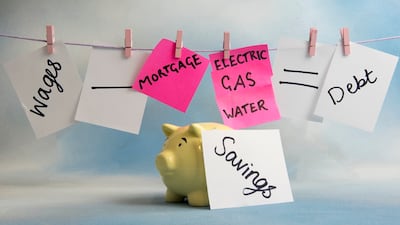We have spent almost two years worrying about our physical health, and in that time may have taken our eye off our financial wellbeing.
Being financially healthy is about making sure you can cover day-to-day expenses, plan for the future and cope with the unexpected, enabling you to do the most with what you have. It’s also about what you do with your pot of money, not the size of it.

Financial Health Check special report looks at how we can improve our financial situation, with tips for those having financial problems as well as those looking to invest a lump sum.
[ The Irish Times ePaperOpens in new window ]
True financial wellbeing looks at behaviours relating to how we spend, save, borrow and plan also.
There are many ways to take your financial temperature, according to Dawn Bailey, head of financial wellbeing at Bank of Ireland.
“We have a free financial health check on our website. It’s an easy-to-use, two-minute self-assessment tool with eight questions that will give you a wellbeing score between one and 100 and an explanation of that score and things you can do to improve it. The results are categorised as struggling, stretched, managing or thriving,” she says.
The national financial wellbeing score, based on Bank of Ireland research in 2021, is 64, which means the majority of Irish people are managing financially.
Robert Whelan, managing director of Rockwell Financial, says a very initial acid test is to ask yourself, when making a significant purchase, are you putting it on your credit card or your debit card. If you have the balance in your current account to pay for that item, then you’re financially healthy. But if you’re putting large items on credit and not paying them off at the end of the month, this could signal a problem.
As with physical fitness, you never say, “Okay I’m done with that exercise”, it’s a continuous journey, and financial fitness is no different, Emmet Rennick, managing director at Financial Wellbeanz says. “It’s an ongoing discipline that needs to be maintained.”
Bills
There are three objective measures to look at: the ability to manage everyday expenditure, financial resilience and planning for the future.
“People who at the end of month are running out of money yet they still have bills coming in, that signals a problem. Assuming you have that covered, then there is financial resilience. Life is uncertain and things come out of the blue, for example a broken boiler or car. An emergency or rainy day fund is separate and is important for those things. People who have that are mentally in a better space. If you have to go to a money lender or put it on to credit cards, then you’re immediately into a spiral situation.
“Lastly, are you able to save for the future- that may be buying a car or house in three years’ time, or planning for your retirement. Being able to save for those big events is important. You might meet level one and level two, but if you’re not able to plan for the future that’s a problem too,” Rennick says.
The quickest way for anyone to get in shape is to go three years without taking anything from any pay rise you might be given, according to Whelan, living on just your current salary in that time frame. “For example, with a pay rise of 5 per cent, you save that instead of spending it. You’re not missing that money. This offers an effective outcome for people as they’re not losing anything and it’s the least painful way of doing things,” he says.
Bailey suggest taking a close look at your finances twice a year. “When you take your financial health check we would always suggest sitting down and drafting a budget. Get a full picture of your entire financial situation, all earnings and all outgoings. This will give you a good sense of where you may need to pull things back a little or how better to make your money work for you. So, to give any changes you make a chance to make an impact we suggest leaving at least six months between each health check,” she says.
When people run into debt they’ve lost control and are almost hiding from it, Rennick says. “It’s about being comfortable, it’s not a constant worry and also having confidence in the future, a plan or roadmap for buying a house and retiring comfortably,” he says.
Savings
To stay on top of financial health, you don’t need an elaborate ledger, a simple pen and paper will do. Having a full picture of your financial situation is critical.
“The 50/30/20 rule is a good place to start. 50 per cent of your finances should go to your needs, 30 per cent to wants and 20 per cent to savings. The main areas where we nationally tend to struggle continues to be savings, especially having enough savings to meet our long-term financial goals, and planning ahead to have sufficient insurance coverage for emergencies is a problem area,” Bailey says.
“We also recommend sitting with a financial adviser every so often too. They are the experts, often your bank will provide it as a free service, and they may be able to recommend actions for you to take to support your future financial goals,” she adds.
Finance is not a dirty word, Bailey stresses. “Speak about your financial situation and ambitions more freely. It’s amazing what we can learn from others when we share our thoughts. Chatting to friends and family is great but nothing beats a conversation with a professional. Make time for your finances in 2022 and meet a financial adviser. They will look at the here and now and help set you up to achieve any financial goals you may have from buying a home, saving for children’s education or taking the first step into the world of investing,” she concludes.












